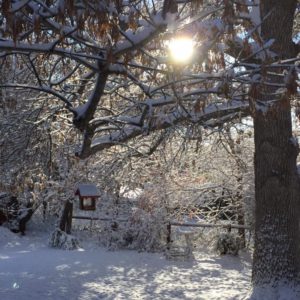Tip Of The Week! What To Expect When Temps Drop So Drastically
 In typical Colorado style, an 80-degree day gets slammed by the big chill overnight. This heads-up wink from winter has sent Indian summer on its way. Though we don’t like to think about it, it’s really life as usual along Colorado’s Front Range.
In typical Colorado style, an 80-degree day gets slammed by the big chill overnight. This heads-up wink from winter has sent Indian summer on its way. Though we don’t like to think about it, it’s really life as usual along Colorado’s Front Range.
So what does the quick temperature shift and hard freeze mean for our plant materials? Maybe a combination of good news and not-so-good news.
On the positive side, it’s less likely that our overnight 60-degree temperature swing will be as damaging to plant materials as the fast freeze of November 2014. This year, plants had begun to transition into dormancy following the earlier frost. Unlike 2014, most leaves have already fallen. This also means less potential weighing down and breaking of branches because snow was clinging to leaves.
In general, new plants in the landscape will suffer more than mature plants. Established native plants such as chokecherry and serviceberry, on the other hand, may skate through the ice and cold with no damage. They are born survivors in Colorado’s climate.
The trees most damaged in 2014 will likely be the same ones to see damage this time around. This will include species being grown here that are pushing the warm edge of the plant hardiness zone, plus ornamental pears and prunus varieties such as Newport plum and weeping cherry. We won’t know to what extent these plants have suffered until spring.
Plants that have already set flower buds for spring blooms may also have damage. This includes forsythia and flowering quince. Lilac and viburnum, on the other hand, are more cold hardy and less likely to be damaged. You can find lilacs blooming in Leadville, Colorado’s highest and very cold city.
Flowering ornamental trees such as crabapple, red bud and hawthorn may also suffer flower bud damage. The spring will tell.
Lawns should not be damaged by the freeze as the soil has been warm. They are more likely to be harmed from the hot/dry days of fall and any continuing dry conditions during the winter.
Any remaining annuals that were hanging on to the growing season have now departed and the long wait ’til the next growing season begins. About all we can do is cozy up to the fire and dream of spring.



